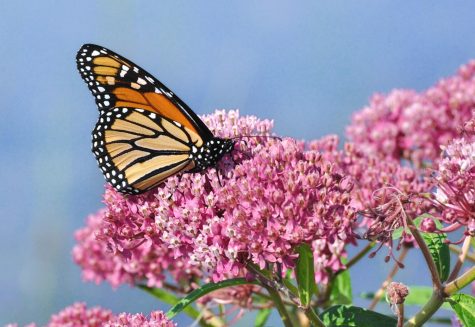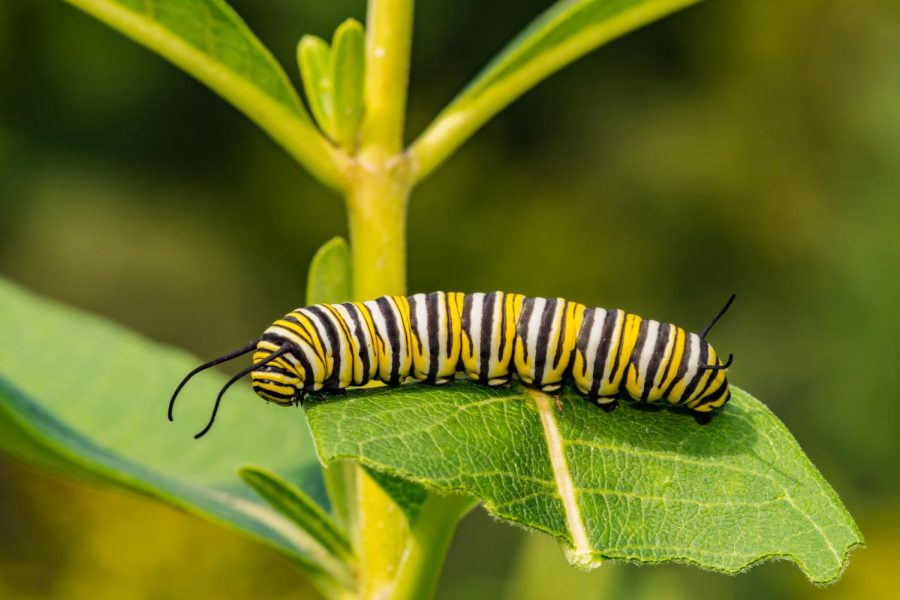Monarchs and Milkweed
October 5, 2022
Insatiably hungry, full of intelligence, and resistant to chemicals that could stop your heart, the monarch caterpillar is truly an amazing creature. Within its black, yellow and white-striped body—a color scheme that even humans use for caution signs—poisons lurk and are harbored for protection. The caterpillars, and later in life their metamorphic butterfly form too, are extremely toxic if eaten by other animals, a deadly meal for a fox, bird, or squirrel. The toxins are not produced by the caterpillar but, instead, are present in its body as a direct result of its diet; as in, it is what it eats. The monarch caterpillar is ruled by a voracious appetite, but has a taste for one thing, and one thing only: milkweed.
Plants all produce their own defense chemicals, called secondary compounds, because they’ve evolved for millions of years to 1) reproduce, and 2) not get eaten. Milkweed, a plant native to Maryland, is no exception. Milkweed uses some of the energy it makes from photosynthesis to toxify every part of its body, rendering herbivory of the plant almost impossible. When milkweed is ingested, its poisons, which are stored from head-to-toe of the roots, stem, leaves and flowers, cause the heart to beat erratically and go haywire. For insects, this basically means a heart attack and certain death. But the plant doesn’t stop at cardiac poisons. Milkweed gets its common name because it secretes a milky white sap when the plant is damaged, like if an insect were to take a bite out of a leaf. Not only is that sap poisonous, but it’s also a trap.
Imagine a caterpillar chewing its way through a juicy looking leaf of milkweed. Milky sap starts to flow and sticks to the face and mouthparts of the caterpillar. Big deal, right? Maybe it tastes good. Here’s the thing—that milky sap that was flowing a second ago begins to firm up and congeal. The chomping of the caterpillar comes to a stop because its mouth gets glued shut. The clock of doom begins ticking until the caterpillar starves to death, its mandibles clasped closed. But how is it, then, that monarch caterpillars are able to eat this crazy plant?
Aside from the ability to stomach poison, monarch caterpillars also have a behavioral adaptation, a fancy way of saying they behave a certain way. This behavior ultimately leads to a workaround to, and disarmament of, the insidious glue trap. Picture this: a monarch caterpillar, decked out in its yellow, white and black stripes starts munching on some milkweed leaves. The poisons in the plant find their way to the gut but have no effect, and the caterpillar keeps on munching. The milky sap starts to ooze out of the leaves. As soon as the sap appears, the monarch stops eating. It inches and crawls its way to the midrib (the giant vein down the middle) of the leaf. The midrib is like the plumbing, the piping that pumps the milkweed sap to the extremities of the leaf. After a few moments of nibbling, the monarch takes a chunk out of the midrib, stifling the flow of the milky sap. Then, taking its time, the caterpillar goes right back to its original spot and keeps on eating. There is nothing left to fear; the leaf has run dry.

If you’re still not convinced how cool of a duo this caterpillar and plant make, there’s more. The only place in the entire world where monarch butterflies lay their eggs is on milkweed leaves. In return for a nesting ground, food, and shelter, the monarch butterfly pollinates the flowers of milkweed. Butterflies each have a long, curled up sucking mouthpart called a proboscis. When a butterfly wants to take a drink, it uncurls this thin appendage and inserts it into the nectary of the flower. Nectaries are often super slender and delicate structures with a particular shape that only allows entry if an organism has the perfect anatomy for access. At the bottom of the nectary is nutritious nectar. While the butterfly drinks, the pollen from the flower brushes against its head, which the butterfly will then carry to the next flower. When the butterfly lands and begins to drink again, the pollen gets transferred to the new flower and is thus considered pollinated!
Eastern monarch butterflies stock up on energy from nectaries and burn it during an incredible annual massive migration down south. The monarchs brave a mammoth distance of up to 3,000 miles to the mountains of Central Mexico. Within the forests docked atop the Sierra Madre mountains can be found the butterflies’ preferred trees, called sacred fir, one of the only places in the world where they grow. The trees act as the overwinter landing strips and resting places for the weary winged pilgrims. To stay warm at such a high elevation, monarch butterflies huddle together in massive clusters to share body heat, with, according to the U.S. Forest Service, tens of thousands of monarchs taking up every inch of the surface of a single tree.
According to an Integrative Pest Management (IPM) report from the University of Maryland, the majestic monarch population is in steep decline, with population numbers approaching dire lows over the last two decades. The report states “the Eastern monarch population has declined by 80%,” and the western monarch population was tallied at a total of less than 2,000 individuals in 2020. Butterfly habitat has been gradually shrinking and fragmenting for decades (if not hundreds of years) as plants and trees are uprooted and replaced with buildings, pavement and developments. However, there is good news, an unexplained miracle. The same report quotes western monarch populations to have miraculously increased by 100 fold this past year, with over 200,000 monarchs having been observed. While this is definitely encouraging, it is by no means a complete turnaround. Seemingly, an extinction was narrowly avoided, at least for now. Surely there is something we can do to help?

If you see holes in a milkweed plant, they were probably made by hungry monarch caterpillars. There’s tons of milkweed growing around campus, especially in mulch patches. It can be pretty tall, too, upwards of 3-5 feet in height when conditions are right. Keep an eye out for its fruit, which grows horizontally, is green, and shaped like a cross between a cucumber and a Hershey’s kiss—a really big Hershey’s kiss. See if you can find the caterpillars, and bear witness to the magnificence of their transformation. The butterflies are strikingly beautiful, with brilliantly bright orange variegated by deep black, and accented by flecked dotting patterns of white that speckle the central body and outer edges of the wings. If you see one, maybe pause a second, take a breath, and appreciate this incredible being sharing its splendor.
There are multiple kinds of milkweed that grow around Maryland, two of which are called swamp milkweed and butterfly milkweed. Both will attract monarch butterflies. If you’re interested in contributing to the effort to preserve, conserve, and ultimately reestablish the monarch population, the best thing to do is plant. The more milkweed there is around Maryland, the more habitat and food is available for this species to survive. So, got milkweed?
